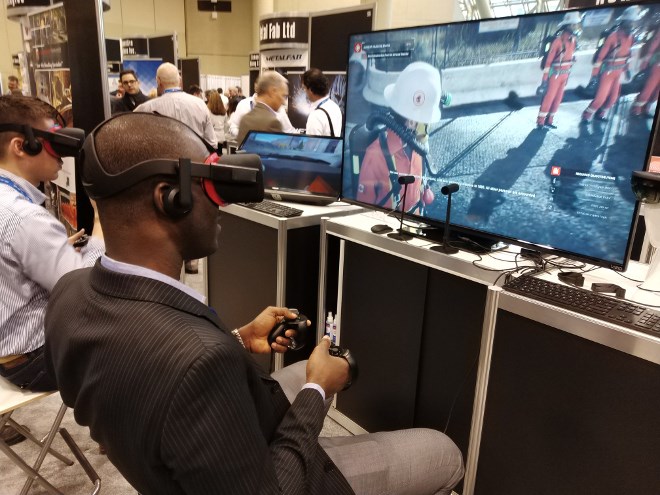As the workforce becomes more technical, so do the methods in which people are trained for careers.
NORCAT has been working on this model since its inception and recently revealed the latest teaching tools to give students an interactive and immersive experience in a safe environment.
It debuted two new experimental programs at PDAC the week of March 4 to 7 in the Northern Ontario Pavilion.
They launched three programs: an induction training program described as a “ride along,” simulator program where people “drove” a Load, Haul, Dump (LHD) with an avatar of a site manager. They also launched virtual reality-based mine rescue program, to deliver a tailored-to-the-client, team-based learning. They also introduced a training tool that consisted of a tablet mounted to a fire extinguisher that ran a real-time augmented reality simulation of a fire emergency.
The reaction from the public, said CEO Don Duval, was immediate and very exciting.
“It was exceptional,” he said. “It aligns to our mandate to become a global leader in skilled training development. These create a meaningful learning experience that resembles the true environment. That's why we've done it.”
He said the programs were developed based on feedback from NORCAT’s global mining partners that identified the need to provide workers with the skills and confidence to implement, operate, and manage emerging technologies that are being adopted by and transforming the global mining industry.
Speaking specifically to the programs, the fire extinguisher is designed where people look at the screen, which is mounted in a way to simulate reality, as they run a program to find an object in a room, “set” it on fire, and extinguish it with the pull, aim, squeeze and sweep technique.
The program helps eliminate errors with built-in mechanisms to show the user how to go through the correct motions, Duval said. The fire will continue to expand if they are not attacking the fire using the correct mechanisms.
The reason to have a simulated fire? There's a lot of risk in setting things on fire and extinguishing them safely.
“It allows for a meaningful learning experience without putting an individual at risk,” he said.
The same need for meaningful engagement and safety is applied to the induction training program, where people “drive” the LHD with an avatar of the site manager they will eventually meet in reality to learn the rules and site plan before they arrive.
In the mine rescue simulation, clients can design a simulation that mimics a true situation that people can participate in from anywhere in the world.
“There could be five people, in five different locations, all immersed in this mine rescue simulation,” Duval said. “They recognize that no matter where they are, they have to work together to accomplish this mine rescue.”
That involves high-risk activities they must do to collectively in the simulation to solve the issue, but again, it is done in a safe environment, he added.
The new programs are delivered through a combination of hands-on, experiential training at the NORCAT Underground Centre and instructor-led classroom-based learning.
“We spend a lot of time meeting with customers, understanding what are the challenges, what are the opportunities that they see from the human capital strategies, as well as, more specifically, training and development,” he said.
Over the last three years, Duval said they found the more important questions relating to the technical transformation of the mining industry and how it supports the new world of training and development.
What the industry is specifically asking, he said, is:
1. How do they maximize knowledge retention and achieve meaningful learning outcome with training and development programs?
2. How do they provide meaningful experiential training for higher risk activities that are hard to replicate in the real world?
3. How do they provide a mechanism of training that aligns with expectations of new and existing new workers?
When people removed themselves from that immersed experience, Duval said people were very excited to have conversations with their colleagues.
“It isn't just the content, but the mechanism,” he said. “The medium is the message. The experience was as important as the content.”
NORCAT has found people want to learn in different ways. Duval said some people coming to the booth were interested in instructor-led training, while others preferred either augmented reality or virtual reality.
After PDAC, he said they learned the delivery method depends on how the person wants to learn. In the future, NORCAT will be building programming around the right content and clearly defining learning outcomes and how to get there.
Duval envisions a world where contractors and employers will ask workers how they would like to learn new skills and build training models around the individuals to maximize learning.
And that comes back to NORCAT's mandate to be the leaders in developing and delivering training programs.
“We are defining the future of training and development to support the new world of work,” he said.
“We have a 25-year history of building, developing and delivering world-class training and development programs,” Duval said. “In order to maintain that global reputation of being the leader in skilled labour training and development, we invest and engage a significant amount of time with our customers. We've learned over the years this is the future.”
The programs are still being developed with customer input to tailor them to their site-specific needs, he said. They are all custom designs.




